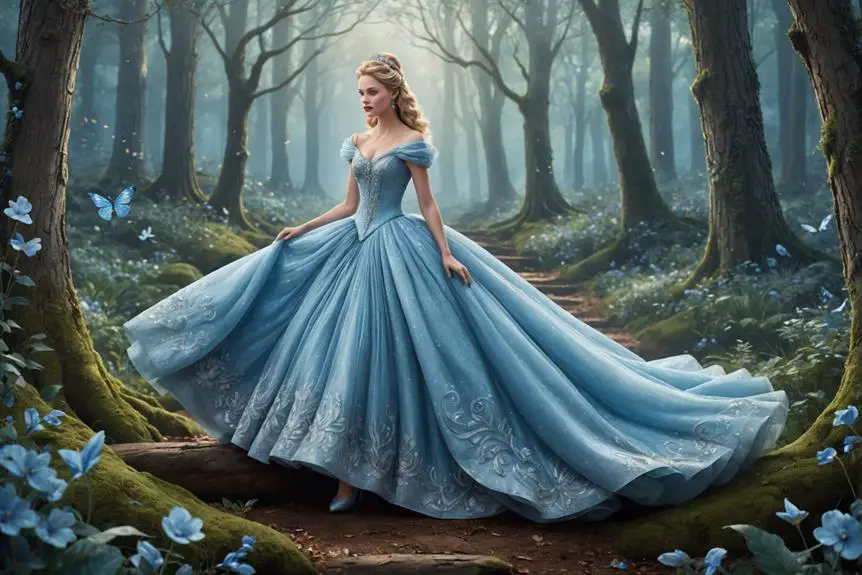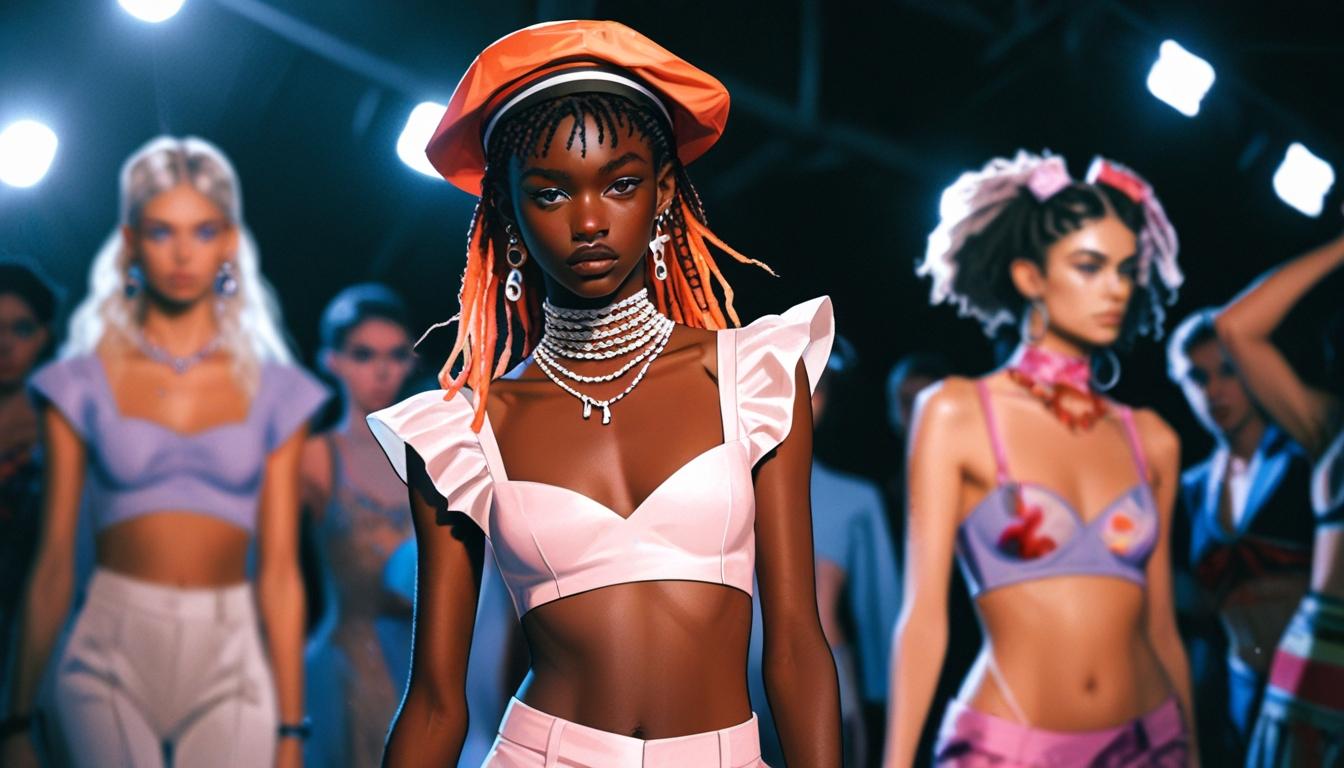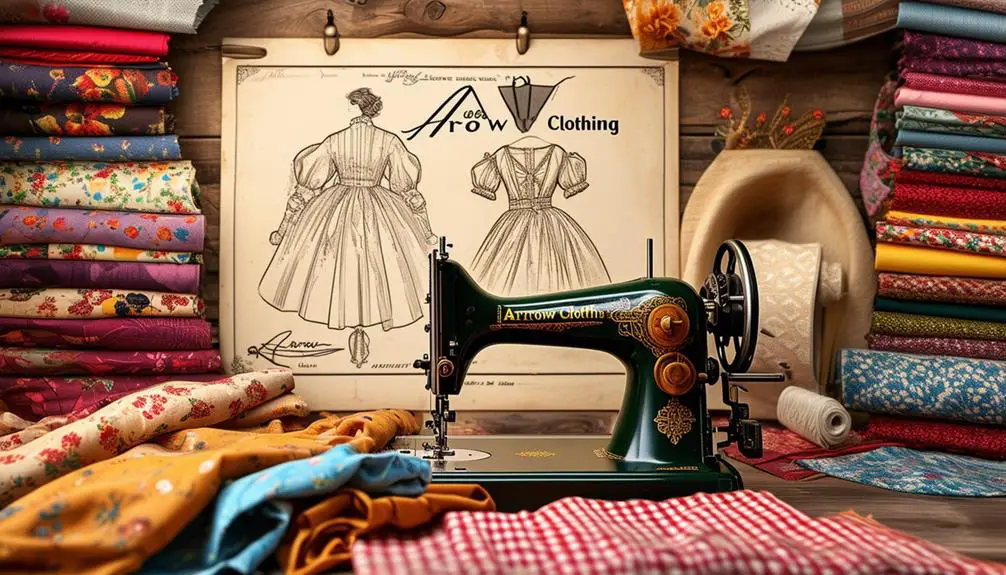Is it possible that the outfits in the 2015 adaptation of "Cinderella" serve as more than just visual splendor? By examining the intricate designs and their symbolism, you might uncover deeper narratives about character development and societal themes. From Cinderella's transformative gown to the oppressive palette of her stepmother, each piece contributes considerably to the story's emotional weight. What might these choices reveal about the filmmakers' intentions and the characters themselves? Exploring these elements could offer unexpected insights into the film's underlying messages.
Dress Overview and Design Features
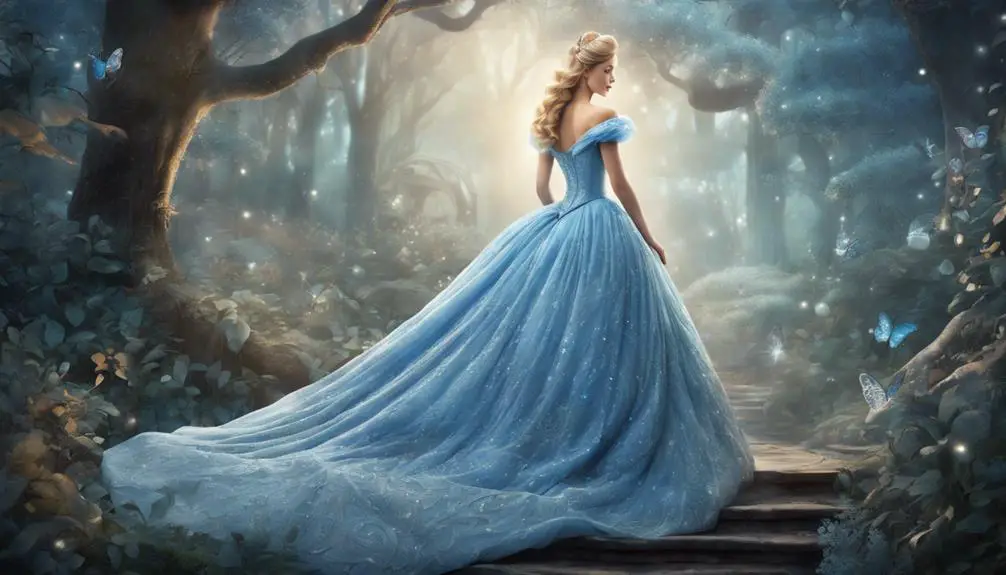
The iconic dress in *Cinderella* (2015) captures attention with its exquisite design features. You can't help but admire the stunning craftsmanship that went into creating this magical ball gown. Designed by the talented costume designer Sandy Powell, the dress perfectly balances historical accuracy with a whimsical flair.
Let's explore the dress overview! The bodice is smocked with a wide square neckline, boasting about 112 pleats. That's some serious attention to detail! Made from soft cotton voile, the outer fabric has a ruffled edge at the neckline, beautifully accented with coral and peach piping. It adds a delicate touch, don't you think?
Now, check out the skirt! With a full circumference of around 5 yards, it's ankle-length and made to twirl. The tightly gathered fabric at the waist creates that lovely flared look we all dream about. And the hand-sewn details? Absolutely charming! The hem is decorated with evenly spaced flowers in coral, tan, and green, along with a subtle leaf pattern that complements the dress color.
You'll also notice the back fastens with hooks and eyes, while a piece of boning gives the bodice a structured silhouette. It's like a fairy tale brought to life! This dress isn't just about looking pretty; it's a stunning representation of craftsmanship and creativity that captures the heart of *Cinderella*'s story. Who wouldn't want to wear something so enchanting?
Additional Garments and Undergarments
Now that you've seen Cinderella's stunning dress, let's chat about the cool undergarments and aprons that make the outfit pop! Did you know that her corset not only looks fabulous but also adds a touch of history to the whole vibe? Plus, the different apron styles—like the work apron and the pretty coral one—really show off how layering adds depth and authenticity to her character!
Undergarments' Historical Significance
Throughout history, undergarments have played an essential role in shaping women's fashion and societal roles, as seen in Cinderella's attire. You might not think about it, but these pieces are super important! Take Cinderella's chemise, for example. This full-length, cream-colored garment isn't just pretty; it provides modesty and comfort beneath her beautiful dress.
And let's talk about that corset! It helps create that classic hourglass figure, emphasizing Cinderella's innocence compared to her stepfamily's opulence. Pretty neat, right? The underskirt, often light blue or aqua, adds structure to her gown, making it flared and fabulous.
Now, historical accuracy matters, especially with details like smocking and cartridge pleating. These techniques give us insight into the fashion practices of the time, making the costumes even more authentic. It's fascinating to think about how these undergarments not only served practical purposes but also reflected social roles.
Apron Styles and Functions
In Cinderella's story, aprons play a significant role in showcasing her character and the era's fashion norms. You might not think much of them, but these garments tell a lot about who she is. Cinderella wears two distinct apron styles throughout the film. First, there's the sturdy work apron made from thicker cotton, perfect for all her chores. This practical piece has pockets for tools, making her daily tasks a bit easier.
Then, there's the stunning decorative apron. It's coral-colored and features an embroidered hem, adding a splash of elegance to her look during special moments. This lighter apron not only highlights her femininity but also connects her to her mother. Who doesn't love a little reminder of family?
Together, these aprons reflect a unique costume aesthetic, with each serving its own function. The work apron shows her grit, while the decorative apron symbolizes hope and beauty. Isn't it amazing how something as simple as an apron can have such depth? So, next time you see Cinderella in her aprons, you'll appreciate how they help tell her story!
Layering for Authenticity
When you look at Cinderella's costume, the layering of her garments really enhances the authenticity of her character. It's not just a pretty dress; it's a carefully crafted period piece! For starters, that full-length cream-colored chemise is essential. It's textured and has a drawstring neckline, serving as the vital undergarment. Then there's the light blue underskirt, which adds volume and structure, making the gown really stand out.
But wait, there's more! Cinderella sports two distinct aprons. The first one is a tightly gathered work apron made from thicker cotton—perfect for doing chores. The second is a lightweight, decorative coral-colored apron with an embroidered hem, adding a splash of fun.
Don't forget the corset! It helps create that fitted bodice and flared look, giving Cinderella her signature silhouette. All this layering not only emphasizes historical accuracy but also showcases the typical undergarments of her era. So, when you think about Cinderella's costume, remember that each layer tells a story, bringing her character to life in a way that feels real and authentic. Isn't that just magical?
Costume Analysis and Historical Context
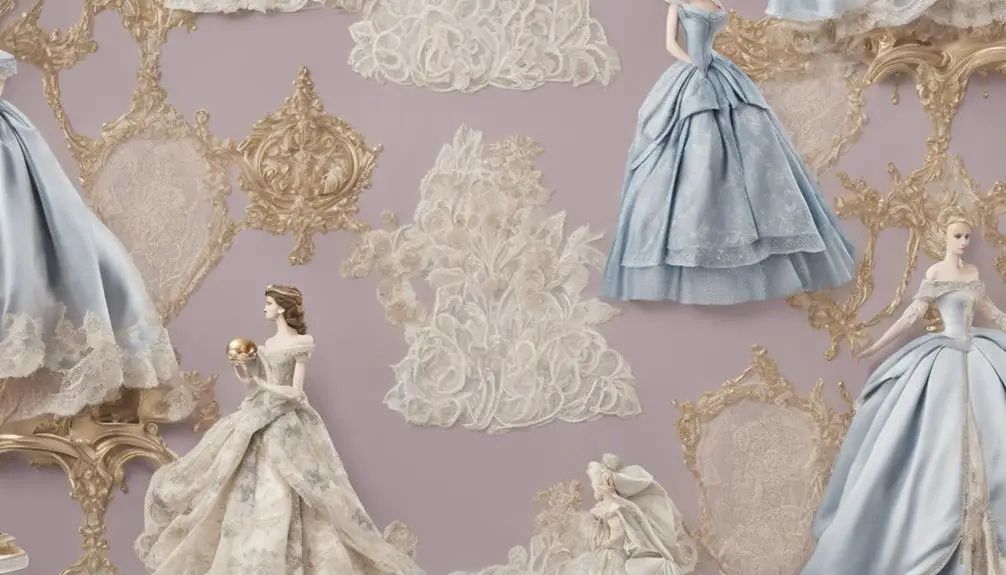
Costumes in *Cinderella* (2015) serve as essential storytelling elements that bridge historical fashion with the film's enchanting narrative. You've got to admit, Cinderella's ball gown is a standout piece! Designed by the talented Sandy Powell, this gown takes cues from both the beloved animated classic and real-life historical gowns, particularly a stunning 1951 Dior design. It's a perfect blend of fantasy and fashion that makes you dream of twirling in a magical ballroom.
Now, let's talk about the stepmother's costumes. They're striking, right? With a color palette of greens, yellows, and blacks, her outfits scream elegance and authority. Inspired by Hollywood icons like Marlene Dietrich, these looks help define her character as both stylish and sinister. How cool is it that historical fashion can tell us so much about who these characters are?
Sandy Powell didn't just pull these designs out of a hat; she carefully crafted them to reflect various historical periods, from the 17th century to the 1940s. This costume analysis reveals how each outfit not only enhances the visual splendor but also deepens our understanding of the characters. Sure, some critics debated the historical accuracy, but isn't it fascinating how creative liberties can create a stunning spectacle that fits the fairy tale vibe? So the next time you watch *Cinderella*, pay attention to those costumes—there's a whole lot of history and story wrapped up in those beautiful fabrics!
Character Costumes and Their Symbolism
While each character's costume in *Cinderella* plays an essential role in storytelling, they also serve as powerful symbols that reflect their personalities and arcs. Take Cinderella's ball gown, for instance. That stunning blue dress doesn't just make her look beautiful; it represents her connection to her mother and her inner strength. In contrast, the Wicked Stepmother's costume, inspired by iconic stars like Marlene Dietrich, uses a dark palette of greens, yellows, and blacks to create an intimidating presence. You can practically feel her oppressive nature just by looking at her!
Then there are the Stepsisters' outfits, which are hilarious in their exaggerated styles and bright colors. They highlight their ridiculousness and poor taste, making them the comedic antagonists of the story. It's hard not to chuckle at their over-the-top fashion choices!
Now, let's not forget the Fairy Godmother. Her gown, bright white with LED lights, is a nod to Elizabethan fashion, and it embodies the magical transformation theme. She's the whimsical figure who helps Cinderella shine.
And talking about shine, the Prince's attire, featuring white, green, and gold, signifies his wealth and traditional role as Prince Charming. The shared color motifs between him and Cinderella during their encounters visually connect them. Isn't it fascinating how costumes can tell such deep stories? Each outfit adds layers to the characters, making the film even more enchanting!
Iconic Gowns and Their Reception
Let's chat about Cinderella's iconic gown and how its design has evolved over time. You might have noticed that some fans were bummed when the dress didn't match the classic yellow look we all know and love from the animated film. But hey, the blend of history and modern style in her gown tells a story all its own—don't you think that's pretty cool?
Gown Design Evolution
Throughout the years, gown designs in *Cinderella* have evolved considerably, reflecting changes in aesthetics and audience expectations. You might've noticed how the gowns in the animated version had a certain charm, but the 2015 film took it to a whole new level! I was thinking about how stunning the iconic ball gown is, with its multiple layers that create that magical volume and lightness. And let's not forget the watercolor effect, crafted from layers of silk colors that dance beautifully on screen.
Cinderella's transformation dress is another masterpiece, packed with intricate details that symbolize her character growth. It's like a fairy tale brought to life! This gown is sprinkled with 10,000 Swarovski crystals, making it shimmer like the stars. Plus, the design nods to historical gowns, resembling a cerulean gown worn by Queen Elizabeth II in 1948. How cool is that?
However, the gown faced mixed reviews. Some loved its innovative flair, while others longed for the classic yellow ball gown from the animated version. What do you think? Do you prefer the modern take or the classic look?
Audience Expectations vs. Reality
Maneuvering audience expectations can be tricky, especially when it comes to iconic film costumes like Cinderella's ball gown. You probably remember the buzz surrounding the release of *Cinderella* (2015). Fans were enthusiastic to see how the live-action version would bring the beloved animated gown to life. With its multiple layers, stunning watercolor effect, and 10,000 sparkling Swarovski crystals, the gown was a feast for the eyes. But did it meet everyone's expectations?
While some praised the gown's design as a brilliant homage, others felt it didn't fully capture the magic of the classic animated look. The contrast between Cinderella's ethereal gown and her Stepmother's bold style really highlighted the film's themes of class and character growth. Isn't that interesting?
Social media lit up with discussions about the ball gown, showing just how much visual representation matters. You might have seen the mixed reactions, with some fans absolutely loving it and others wishing for something closer to the original. In the end, the gown became a hot topic, proving that the right design could spark joy, debate, and a whole lot of conversation! Isn't that what makes fashion in film so exciting?
Symbolism in Costume Choices
Costume choices in *Cinderella* not only bring characters to life but also weave deeper meanings into the narrative. Take Cinderella's ball gown, for instance. With 10,000 Swarovski crystals, it symbolizes her transformation and connection to her mother. Remember her earlier dresses? They reflect innocence and despair, really pulling at your heartstrings.
Now, let's talk about the Wicked Stepmother's costume. Inspired by 1940s glamour, the green and black colors evoke intimidation and severity, making her the perfect antagonist. You can practically feel her cold glare through that outfit!
Then, there are the Stepsisters' outfits. Bright colors and exaggerated styles showcase their spoiled, over-the-top personalities, adding a touch of comedy to the story—who doesn't love a good laugh?
Sandy Powell's Design Philosophy
Sandy Powell's approach to design showcases her deep commitment to historical accuracy and expressive storytelling. When you watch *Cinderella* (2015), you can't help but notice how each costume tells a story. Powell dives into historical research, making sure every detail counts. Did you know she studied footwear at the Northampton Museum? That dedication led to amazing pieces like the Fairy Godmother's crystal shoe!
Her design philosophy merges different time periods, blending 19th-century styles with flair from the 1940s and 1950s fashion trends. This mix not only looks stunning but also helps with character development. Each costume reflects the personalities and emotions of the characters, making them come alive on screen. Imagine wearing a dress that captures your spirit!
Powell's meticulous attention to detail is vital in costume design. She knows that clothing isn't just about looking good; it's about setting the scene and enhancing the narrative. When Cinderella twirls in her beautiful gown, you're not just seeing fabric—you're witnessing her transformation!
And let's be honest, who doesn't love a good fashion moment? Powell has earned multiple Academy Award nominations for her work, proving how essential costume design is in film. So, next time you watch *Cinderella*, pay attention to the costumes. They're not just pretty; they're a vibrant part of the story. Isn't that just magical?
Frequently Asked Questions
Where Can I Buy Replicas of Cinderella's Gown?
If you're looking to buy replicas of Cinderella's gown, check out Cinderella gown retailers, costume replica websites, or affordable gown options. You might also explore custom gown makers for a unique creation just for you.
How Long Did It Take to Create the Costumes?
Creating costumes can take several months, reflecting a meticulous production timeline. You'll navigate costume challenges and embrace the creative process, crafting designs that bring characters to life, much like weaving dreams into reality.
What Materials Were Used in the Costumes?
When creating costumes, you'll notice fabric choices reflect color symbolism and character influence. The design process involves selecting materials that resonate with emotions and themes, enhancing the story through visual representation and depth.
Who Were the Costume Team Members Besides Sandy Powell?
In the domain of costume design, you'll find that character symbolism and fashion evolution shape stories. Besides Sandy Powell, other talented team members contributed to the vibrant color palette, enhancing the film's visual narrative.
Were Any Costumes Inspired by Real Historical Fashion?
Yes, many costumes draw on historical influences. You'll notice fashion accuracy through period details, showcasing how costume evolution reflects different eras. This blend gives the designs authenticity while enhancing the overall visual storytelling of the film.
